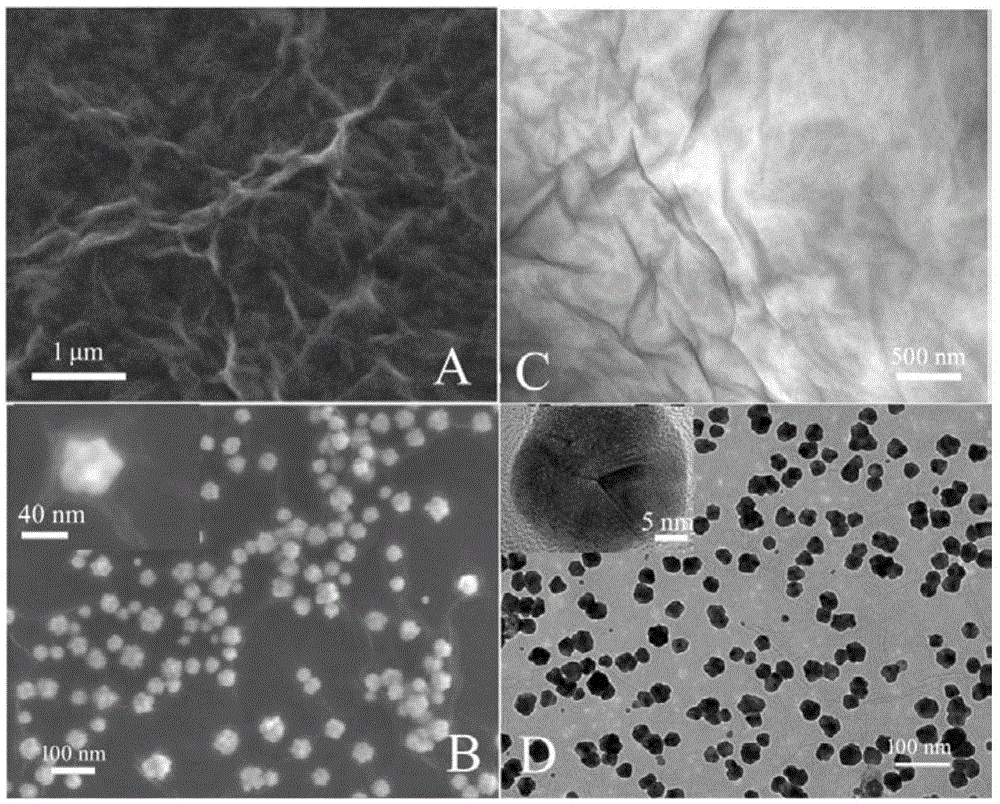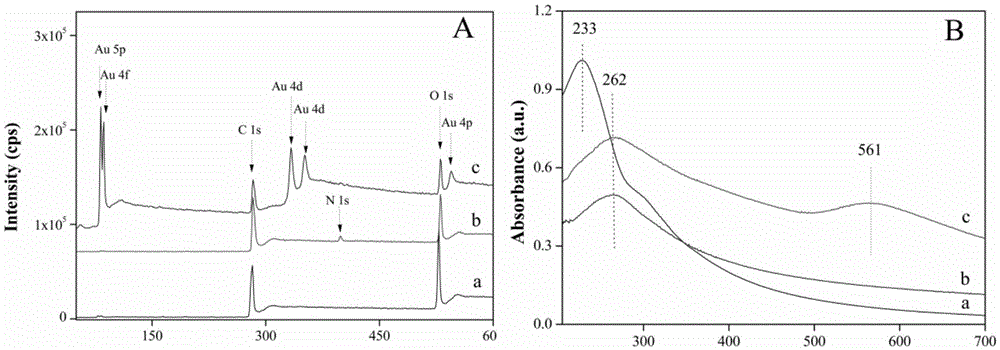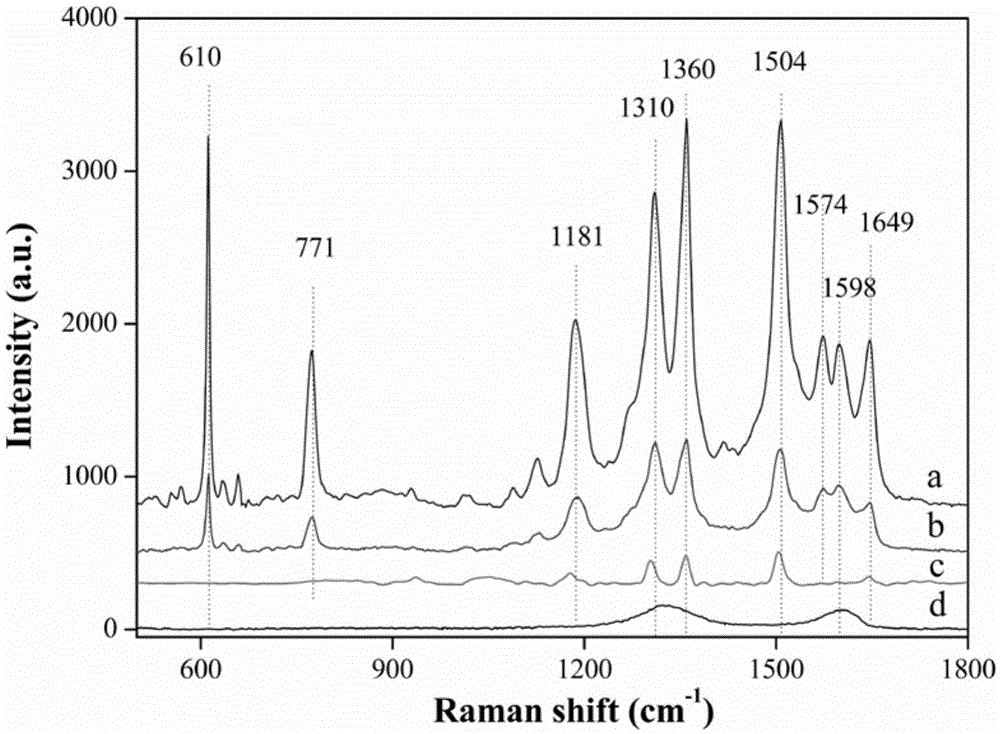Expiration sensor, as well as preparation method and application thereof
A sensor and substrate technology, applied in the field of breath analysis and clinical detection, can solve the problems of weak Raman excitation efficiency and limit wide application, and achieve the effect of Raman enhancement effect, good repeatability and simple process
- Summary
- Abstract
- Description
- Claims
- Application Information
AI Technical Summary
Problems solved by technology
Method used
Image
Examples
Embodiment 1
[0053] Step 1: Sputter a 300nm gold film on the cleaned glass as a substrate. 2 microliters of 0.25 g / L graphene oxide solution was drop-coated on the cleaned substrate surface; after natural drying, the formed graphene oxide film was as follows: figure 1 As shown in A and C, the dispersion is flat.
[0054] Step 2, place it in a space of 50 cubic centimeters, and add 100ml of hydrazine hydrate solution (85%, v / v) to the surrounding area of the substrate as a source of hydrazine vapor, seal it and place it in a thermostat at 37°C for 12 hours ;
[0055] Step 3, after taking it out, let it stand still for half an hour, add 1 microliter of chloroauric acid solution (5mM) dropwise, and let it dry naturally. Finally, the electrodes were carefully washed with water to obtain a breath sensor based on graphene and gold nanoparticles, preserved in N 2 Environment. The obtained sensor surface is as figure 1 As shown in B and D, the AuNPs are uniform in size and well distribute...
Embodiment 2
[0060] Step 1: A 200nm gold film is sputtered on a cleaned silicon wafer as a substrate. 2 microliters of 0.5 g / L graphene oxide solution was drip-coated on the cleaned substrate surface;
[0061] Step 2, after natural drying, place it in a space of 200 cubic centimeters, and add 1000ml hydrazine hydrate solution (85%, v / v) to the surrounding area of the substrate as a source of hydrazine vapor, seal it and place it at a constant temperature of 37°C 12 hours in box.
[0062] Step 3, after taking it out, let it stand still for half an hour, add 1 microliter of chloroplatinic acid solution (10 mM) dropwise, and let it dry naturally. Finally, careful washing with water resulted in a breath sensor based on graphene and platinum nanoparticles. Yield is about 75%.
[0063]The exhalation sensor was placed in a 500ml airbag filled with exhaled air, and was allowed to stand for adsorption at 37°C for 6 hours. After taking out, use HORIBA LabRAMHREvolution spectrophotometer to det...
Embodiment 3
[0065] Step 1, sputtering a 500nm copper film on the cleaned copper sheet as a base. 2 microliters of 0.25 g / L graphene oxide solution was dropped on the surface of the substrate after cleaning;
[0066] Step 2, after natural drying, place it in a space of 50 cubic centimeters, and add 100ml hydrazine hydrate solution (85%) to the surrounding area of the substrate as a source of hydrazine vapor, seal it and place it in a thermostat at 37°C for 12 hours .
[0067] Step 3, after taking it out, let it stand for half an hour, add dropwise 10 microliters of silver nitrate solution (1mM), in N 2 Dry naturally. Finally, careful washing with water resulted in a breath sensor based on graphene and silver nanoparticles. The yield is greater than 63%.
[0068] The exhalation sensor was placed in a 500ml airbag filled with exhaled air, and was allowed to stand for adsorption at 37°C for 3 hours. After taking out, use HORIBA LabRAMHREvolution spectrophotometer to detect, the conditi...
PUM
| Property | Measurement | Unit |
|---|---|---|
| thickness | aaaaa | aaaaa |
| thickness | aaaaa | aaaaa |
Abstract
Description
Claims
Application Information
 Login to View More
Login to View More - R&D
- Intellectual Property
- Life Sciences
- Materials
- Tech Scout
- Unparalleled Data Quality
- Higher Quality Content
- 60% Fewer Hallucinations
Browse by: Latest US Patents, China's latest patents, Technical Efficacy Thesaurus, Application Domain, Technology Topic, Popular Technical Reports.
© 2025 PatSnap. All rights reserved.Legal|Privacy policy|Modern Slavery Act Transparency Statement|Sitemap|About US| Contact US: help@patsnap.com



